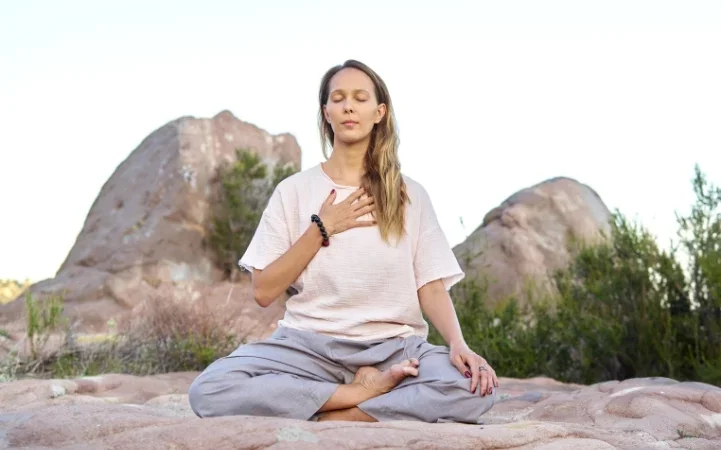Are you looking for a one-stop guide to all your meditation questions? This ultimate guide has everything you need! Read to learn more.
Why does it seem that meditation can be so complicated and difficult to learn?!? In spite of ourselves, we can sometimes make a mess of what should be a simple process, in part because we try too hard. Just like with anything worth mastering, we all need a guide and clear instructions when it comes to meditation. Let’s get you started with our ultimate guide to meditation so you can easily master meditation.
What is meditation?

Sometimes less is more. The fewer concepts we have about what meditation should or shouldn’t be, the better chance we have of having a successful meditation practice. For instance, expecting a thought-free meditation is not only counterproductive, it isn’t possible.
That’s not to say that there couldn’t be periods where your thoughts are so quiet that it feels like you have no thoughts. And after some time practicing meditation regularly, it is possible to experience meditation so deep that thoughts cease to exist for some brief time.
What’s important to know is that meditation is a journey.
Definition of meditation
Now that we have shaken up one of the concepts of meditation a little bit, let’s have some idea of what meditation is and what it isn’t.
- Meditation is:
- The delicate and effortless art of doing nothing
- The skill to calm the mind and get in touch with your inner joy and the source of energy within us
- Deep rest with alertness
- The journey from movement to stillness, from sound to silence
- Mind in the present moment
Meditation is not:
- Mental gymnastics
- Concentration
- Deep sleep
History of meditation

The earliest documented records that mentioned meditation involved Vedantism, which is a Hindu tradition in India, around 1500 BCE. However, historians believe that meditation was practiced before this time, as early as 3000 BCE. Later, between 600-500 BCE, the development of other meditation forms was recorded in Taoist China and Buddhist India.
Though meditation has been around for a very long time, it is fair to say that meditation has never been as popular as it is today– with estimates in the range of half a billion people practicing some form of meditation regularly.
Types of meditation
Some meditation techniques come from ancient traditions, while others are newfangled, modern-day spin-offs. Here’s a breakdown of the various types of meditation.
Mantra-based meditation
Two mantra-based meditation techniques with roots in ancient traditions are transcendental meditation and Sahaj Samadhi (effortless bliss) meditation. Both of these techniques use a Sanskrit sound that becomes an internalized vehicle for silent meditation.
Guided meditation
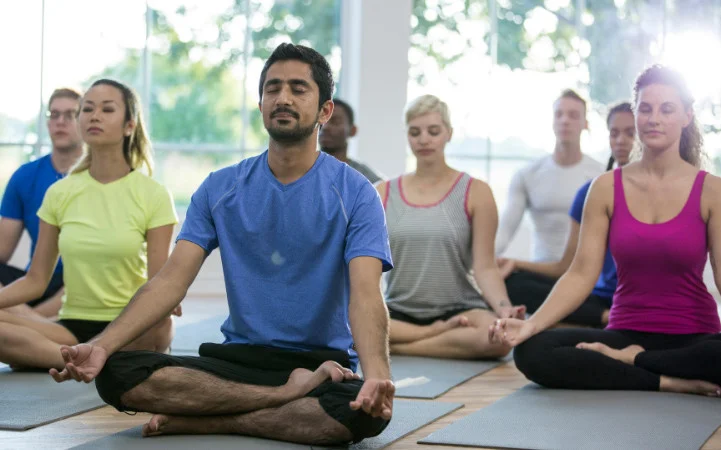
Though this type of meditation has been around for thousands of years, guided meditations are often the go-to method for newbies. One reason guided meditations are so popular is that they can temporarily relieve anxiety, stress, sleep issues, and more without learning a meditation technique.
Mindfulness meditation
Known as a more challenging method of meditation, mindfulness meditation is believed to have started about 2500 years ago with Buddhism. Today, some meditation masters believe that mindfulness is more easily attained as a benefit due to long-term meditation practice.
Breath-based meditation
SKY Breath Meditation (Sudarshan Kriya) is by far the most popular breath-based meditation with more than 450 million practitioners worldwide. With research to back up the popularity, SKY is a technique that anyone can easily practice and enjoy numerous benefits.
Benefits of meditation

Physical health benefits
- Reduces stress and increases relaxation
- Improves overall health
- Boosts energy levels
- Strengthens immune system
- Healthier blood pressure
- Reduced addictive behaviors
Mental health benefits
- Greater clarity of mind and mental focus
- Enhanced deep sleep
- Enhances brain function
- Improves ability to manage challenging situations
- Boosts creativity
- Relieves depression
- Reduces anxiety
- Enhanced optimism
- More ease and harmony in personal and work relationships
- Improves patience
- Increases confidence and self-esteem
Spiritual benefits
- Enhances yoga and meditation practices
- Increases inner peace
- Deeper connection with your inner self
- Increases compassion
How to meditate
Check out our infographic outlining the basics of meditation practice.

Preparing for meditation
Though we might like to think we could just sit up in bed after sleeping all night or rush in after a full day’s work to sit for meditation, there are some things you should do to prepare yourself for meditation.
If you’re meditating first thing in the morning, plan on showering first. Avoid eating or consuming caffeine until after meditating. You might also want to do some yoga or take a brisk walk before meditating. And always make sure your phone is muted.
If you’re meditating mid-day or after work, some of the same preparations apply. Make sure it has been about two hours since you ate or consumed any caffeinated beverages. A little light yoga will help settle your mind and body before sitting for meditation. You won’t need to shower unless you want to, but freshening up will be helpful if you’re feeling tired. And as always, mute your phone.
Breathing exercises, also called pranayama, are the best possible preparation for meditation. Here’s an easy, yet powerful technique you can try for yourself– Bellows breath.
Noopur Umarji Breathing Technique – Bhastrika Pranayama
Basic meditation techniques
Many beginners start with basic meditation techniques like breath awareness meditation, walking meditation, or progressive muscle relaxation (also called a body scan meditation or Yoga Nidra). Enjoy this version guided by meditation master, Gurudev Sri Sri Ravi Shankar.
Yoga Nidra – Guided Meditation for Sleep & Relaxation by Gurudev | Non-Sleep Deep Rest (NSDR)
Advanced meditation techniques
Advanced techniques do not necessarily mean they are difficult to practice. For example, samadhi meditation is considered the highest form of meditation, yet with proper instruction a beginner can easily practice Art of Living’s Sahaj Samadhi meditation.
Similarly, SKY Breath Meditation is powerful but virtually anyone can learn and practice on their own. Silent retreats are also seen as advanced meditation programs, but when structured and curated by an experienced teacher– a beginner can enjoy the benefits as much as an experienced meditator.
Common challenges and solutions
Sometimes challenges can come up. In fact, everyone at some point will have some kind of challenge related to meditation. But no worries, challenges don’t have to be an obstacle to meditation, there are solutions!
- Body aches- try some gentle yoga or sit in a chair
- Fidgeting- shake your hands or jump around before sitting for meditation
- Too many thoughts- try breathing exercises prior to meditation
- No time- make time and the time spent in meditation will make you more productive
- Too noisy- change location, time, or both (you can also try noise-canceling headphones)
- Nothing is happening- speak with a certified meditation instructor, change your technique, or just be patient that this too shall pass
Meditation tips and tricks
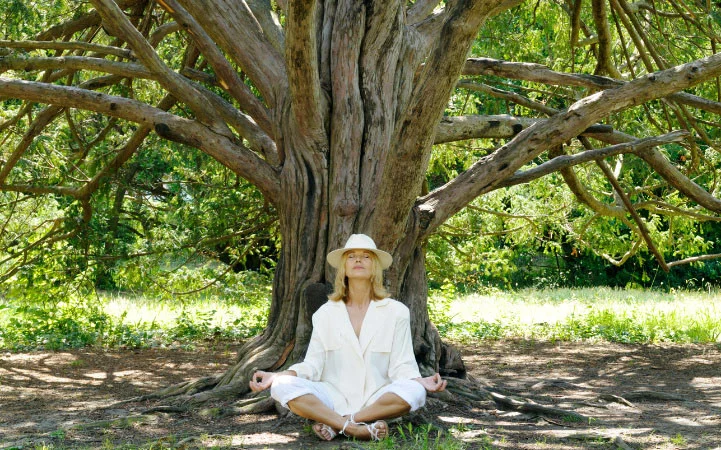
Creating a meditation space
There are many reasons why it is good to create a space for your meditation practice. First, it is a subtle way to honor your practice. Second, whether it is a corner of a room or a designated room– walking by your meditation space becomes a gentle reminder to practice meditation. Third, it’s fun! Here are some things to keep in mind when creating your meditation space.
1. Make sure the space is quiet and clean.
2. Make sure your space is comfortable and has access to fresh air.
3. You can use a meditation cushion or chair for meditation. Best not to use a bed since beds are filled with sleep vibes, not meditation vibes.
4. Personalize your space. Make it an appealing space to spend time there.
Incorporating meditation into your daily routine
When you are new to meditation it can be tricky remembering to practice every day. It is said that it takes about 40 days to create a new habit. You can set yourself up for success by scheduling your meditation time.
First thing in the morning, after showering, is typically the best time to meditate. It’s also good to set an intention or commitment. If you set a goal for 40 days straight and miss a day, restart your counter until you have completed your goal. Your future self will thank you!
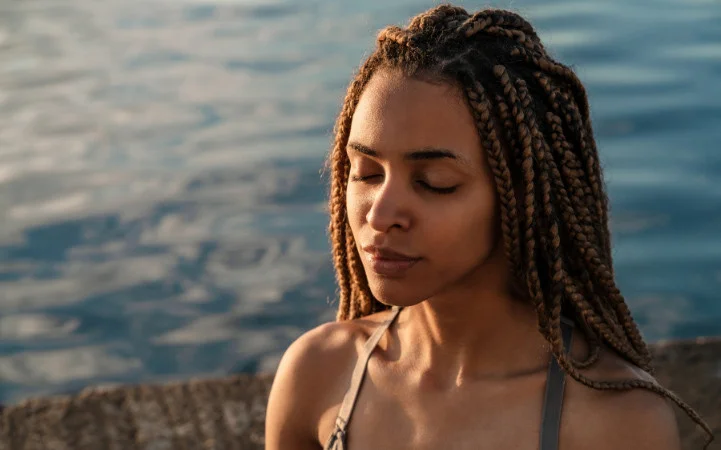
Meditation apps and resources
☐Online Bookstore
☐Guided meditations
☐Journey app
☐Retreat Center
☐Meetups
☐Online Yoga Studio
☐Art of Living YouTube
☐Wisdom snippets
Frequently asked questions
Q: Can you teach yourself to meditate?
A: Anyone who has tried to read a book and teach themselves to meditate will eventually seek out a teacher. This is one area of life that requires the guidance of an expert. Learning to meditate from a trained meditation instructor gives you a proven meditation technique and ensures your success.
Q: How long does it take for meditation to work?
A: A meditation practice should start yielding results from the first few sessions. But for maximum benefits, you will need to stay with a regular meditation practice for at least 40 days.
Q: How long should I meditate if I’m a beginner?
A: A good rule of thumb is 10 to 20 minutes. Shorter meditations aren’t really meditation; they are better categorized as mindfulness breaks and can be used for momentary relaxation. Try Our 10-Minute Meditation for When Time Is of the Essence.
Q: When is the best time to meditate?
A: First thing in the morning, after showering, and before eating, is the best time to meditate. A morning meditation starts you off on the right foot and makes it easier to create a meditation habit. It is also ok to meditate mid-day and late afternoon provided you do not have a full stomach.
Q: Is it ok to fall asleep in meditation?
A: Though falling asleep during meditation is ok, it isn’t the goal of meditation and only indicates a sleep debt. Sometimes though we think we fall asleep during meditation and we are actually experiencing a deep state of meditation. The surefire way to be sure is whether or not you were snoring. Snoring is obviously connected to the sleep state!
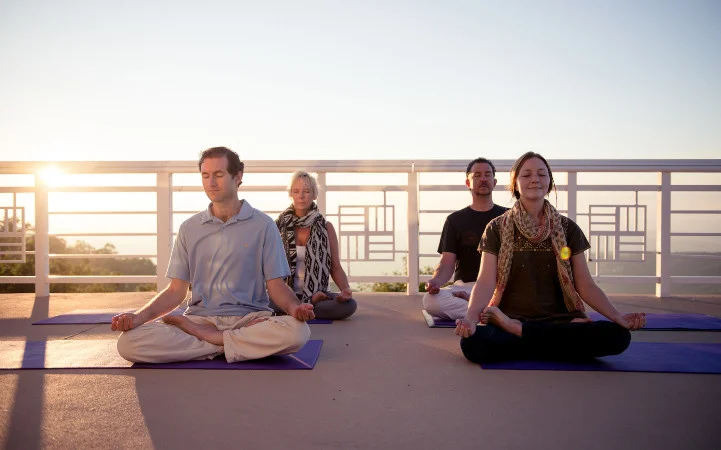
Q: What should you not do during meditation?
A: You should not force meditation. Meditation is meant to be effortless. If you are straining, it is no meditation. Some meditations may feel deep and others may feel shallow and even antsy, it is best not to analyze your experience.
Q: Can you listen to music during meditation?
A: Sometimes listening to music for meditation leads to more thoughts. But using a guided meditation that has some ambient music can also reduce stress and help you have a more effortless meditative experience.
Q: Can you meditate with your eyes open?
A: It is important to withdraw the senses if we want to go inward. If you find yourself struggling to keep your eyes closed you can try 3 things.
1. Do a little yoga or other physical activity before meditation.
2. Wear an eye mask or bandana to help keep the eyes closed.
3. Start your meditation with eyes opened about 30%, with eyes gazing downward. Within a few minutes, your eyes will naturally close.
Q: What should you do if your mind starts wandering?
A: Some random mind wandering is natural, let it be. In fact, it is a sign of stress release. As you become aware that your mind is wandering, it will stop on its own. But if your mind gets on to planning or analyzing, it may be good to either do a guided meditation or learn a specific technique from a certified teacher.
Q: What happens when you meditate every day?
A: Meditating every day builds a foundation of benefits that increase over time. Meditating now and again may cause you to slip backward and lose the benefits you have gained.
Q: How is my breath connected to meditation?
A: The breath is possibly the most effective yet often unrecognized tool for meditation. Starting your meditation with some gentle, easy, longer breaths can be a good way to relax, center, and quiet the mind.
Q: How can I learn more about SKY Breath Meditation?
A: Just attend our free breath and meditation session by clicking the image below. In addition to learning about SKY, you will also experience a live guided meditation and breathing exercise.

